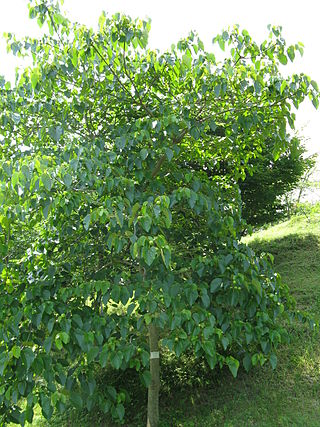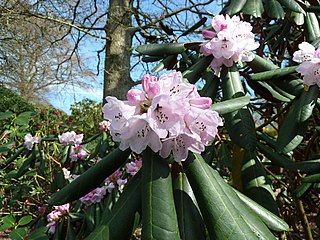
Curtisia dentata is a flowering tree from Southern Africa. It is the sole species in genus Curtisia, which was originally classed as a type of "dogwood" (Cornaceae), but is now placed in its own unique family Curtisiaceae.

Vernicia fordii is a species of flowering plant in the spurge family Euphorbiaceae. It is native to southern China, Myanmar, and northern Vietnam. It is a small to medium-sized deciduous tree growing to 20 m tall, with a spreading crown. The bark is smooth and thin, and bleeds latex if cut. The leaves are alternate, simple, 4.5–25 cm long and 3.5–22 cm broad, heart-shaped or with three shallow, maple-like lobes, green above and below, red conspicuous glands at the base of the leaf, and with a 5.5–26 cm long petiole. The flowers are 2.5–3.5 cm diameter, with five pale pink to purple petals with streaks of darker red or purple in the throat; it is monoecious with individual flowers either male or female, but produced together in the inflorescences. The flowers appear before or with the leaves in loose, terminal clusters. The fruit is a hard, woody pear-shaped berry 4–6 cm long and 3–5 cm diameter, containing four or five large, oily seeds; it is green initially, becoming dull brown when ripe in autumn.

Liriodendron chinense is Asia's native species in the genus Liriodendron. This native of central and southern China grows in the provinces of Anhui, Guangxi, Jiangsu, Fujian, Guizhou, Hubei, Hunan, Jiangxi, Shaanxi, Zhejiang, Sichuan and Yunnan, and also locally in northern Vietnam. Protected populations occur in the Tianmushan National Reserve, Huangshan, Wuyi Shan, and Badagongshan Nature Reserve.

Adansonia madagascariensis or Madagascar baobab is a small to large deciduous tree in the family Malvaceae. It is one of six species of baobab endemic to Madagascar, where it occurs in the Madagascar dry deciduous forests.

Erythrina lysistemon is a species of deciduous tree in the pea family, Fabaceae. It is native to South Africa. Common names include common coral-tree, lucky bean tree, umsintsi (Xhosa), muvhale (Venda), mophete (Tswana), koraalboom of kanniedood (Afrikaans), mokhungwane (Sotho) and mutiti (Shona). It is regularly cultivated as a tree for gardens and parks.

Eucalyptus cinerea, commonly known as the Argyle apple, mealy stringbark or silver dollar tree, is a species of small- to medium-sized tree that is endemic to south-eastern Australia. It has rough, fibrous bark on the trunk and branches, usually only juvenile, glaucous, egg-shaped evergreen leaves, flower buds in groups of three, white flowers and conical to bell-shaped fruit.

Xylotheca kraussiana is an African shrub or small multi-stemmed tree in the family Achariaceae. It grows in the sandveld and is widely distributed throughout the eastern parts of Southern Africa, in particular the eastern Transvaal, coastal Natal and Mozambique, preferring the sandy soils of coastal bush and forest.

Weinmannia trichosperma, the tineo, is an evergreen tree in the family of Cunoniaceae, it is native to Chile and Argentina: 35 to 47°S. endemic to laurel forest habitat.

Haloxylon persicum, the white saxaul, is a small tree belonging to the family Amaranthaceae. Its range is Western Asia, including the Palestine region, Egypt, Sinai, South Iraq, Saudi Arabia, Iran, Oman, UAE, Afghanistan, and Pakistan, to Central Asia, and China.

Chaenomeles cathayensis is a species of flowering plant in the rose family, Rosaceae. It is native to China, Bhutan, and Myanmar. In Chinese, its common name is mùguā hǎitáng (木瓜海棠) or máo yè mùguā (毛葉木瓜).

Dichrostachys cinerea, known as sicklebush, Bell mimosa, Chinese lantern tree or Kalahari Christmas tree, is a legume of the genus Dichrostachys in the family Fabaceae.

Rhodamnia is a group of rainforest trees and shrubs in the myrtle family described as a genus in 1822. They are native to southern China, Southeast Asia, Papuasia, Australia, and New Caledonia.

Cornus controversa, syn. Swida controversa, is a species of flowering plant in the dogwood family Cornaceae. It is native to China, Korea, the Himalayas and Japan. It is a deciduous tree growing to 50 ft (15 m), with multiple tiered branches. Flat panicles of white flowers appear in summer, followed by globose black fruit. Ovate dark green leaves are glaucous underneath and turn red-purple in autumn. It is cultivated in gardens and parks in temperate regions.

Rhododendron fulvum is a species of flowering plant in the heath family Ericaceae, native to northern Myanmar and China. In China, it is found in southwest Sichuan, southeast Xizang, and western Yunnan. It grows at altitudes of 2,700–4,400 m (8,900–14,400 ft). It is an evergreen shrub or small tree growing to 2–8 m (6.6–26.2 ft) in height, with leathery leaves that are oblanceolate to oblong-lanceolate or obovate, 8–20 by 3–7.5 cm in size. The undersides are felted with a striking cinnamon colour. The flowers, borne in trusses in spring, are loosely bell-shaped, pale rose pink, with a crimson basal blotch and sometimes red spots.

Rhododendron watsonii (无柄杜鹃) is a species of flowering plant in the family Ericaceae. It is native to southern Gansu and western Sichuan in China, where it grows at altitudes of 2,500–3,000 m (8,200–9,800 ft). It is an evergreen shrub or small tree growing to 1.5–6 m (4.9–19.7 ft) in height, with leathery leaves that are oblong-elliptic to broadly oblanceolate or obovate, 10–33 by 4–10 cm in size. The flowers are white.

Olinia emarginata, the mountain hard pear or berghardepeer in Afrikaans language, is a tree species in the family Penaeaceae. It is native to South Africa and Lesotho.

Phaleria capitata is a species of flowering plant in the family Thymelaeaceae. It grows as a shrub or small tree up to 10 metres (30 ft) tall, with a stem diameter of up to 15 centimetres (6 in). Twigs are reddish brown. Inflorescences usually bear five flowers. The fruits are roundish, up to 1.5 cm (1 in) long. Habitat is forest from sea-level to 1,200 metres (3,900 ft) altitude. P. capitata grows naturally in Sri Lanka, Peninsular Malaysia, Sumatra, Borneo, Sulawesi, Maluku, the Philippines, New Guinea, the Caroline Islands and Tonga.
Xylopia benthamii is a species of flowering plant of the genus Xylopia, described by Robert Elias Fries in 1900. It contains one subspecies: Xylopia benthamii dolichopetala. The species is native to Venezuela, Peru, Brazil and Bolivia.
Cynometra ananta is a perennial large tree within the Fabaceae family. Its timber is traded under the name Apome in Ivory Coast and Ananta in Ghana.

Gardenia erubescens is a species of shrub or small tree in the family Rubiaceae. It has edible fruits and occurs in the Guinea and Sudan savannah vegetation of West and Central Africa.



















